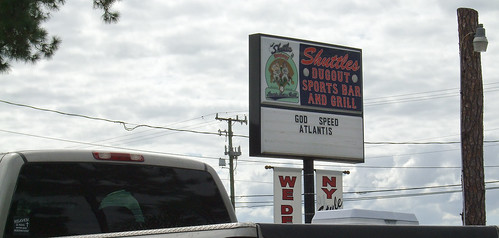
Mission Parameters
Mission Duration: 11 days- Delivering spare parts to the ISS
The spares are going up on two platforms – called external logistics carriers, or ELCs – to be attached on either side of the station’s truss, in hopes that wherever a failure happens, the necessary spare won’t be too far away. The ELCs carried up on STS-129 will be chocked full with two pump modules, two control moment gyroscopes, two nitrogen tank assemblies, an ammonia tank assembly, a high-pressure gas tank, a latching end effector for the station’s robotic arm and a trailing umbilical system reel assembly for the railroad cart that allows the arm to move along the station’s truss system. There’s also a power control unit, a plasma container unit, a cargo transportation container and a battery charge/discharge unit. In all, that’s 27,250 pounds worth of spares to keep the station going long after the shuttles retire.- taken from NASA Mission Overview- Fixing exterior wiring of the ISS (three spacewalks)
- Preparing the interior for the future STS-130 mission, which includes delivery of the last US space station module Tranquility.
- Returning crew Nicole Stott back to Earth.
"I have friends in high places."- a NASA lanyard
 Ever since I moved to Space Coast for my first job in August of 2006, I've witnessed about 14 space shuttle launches from various vantage points. For STS-127, I took Glenn, my faithful motorcycle, up to Titusville in search of Space Park, only to detour into a small neighborhood and watched the night launch from across the intercoastal river. My friends and I have traveled to the parks, the beaches, the bridges (528 and 192), and even one time, Joe was fortunate enough to get launch tickets to view from the NASA Parkway (405), right on the Banana River about 11 miles from the launch pad.
Ever since I moved to Space Coast for my first job in August of 2006, I've witnessed about 14 space shuttle launches from various vantage points. For STS-127, I took Glenn, my faithful motorcycle, up to Titusville in search of Space Park, only to detour into a small neighborhood and watched the night launch from across the intercoastal river. My friends and I have traveled to the parks, the beaches, the bridges (528 and 192), and even one time, Joe was fortunate enough to get launch tickets to view from the NASA Parkway (405), right on the Banana River about 11 miles from the launch pad. Atlantis is my first live shuttle. I've written an entry about it here. On a sunny clear morning of 9 September 2006, Chris (aka "Squirrel") and I decided to drive to Patrick Air Force Base to see if we could get a decent view of STS-115. At the time, I didn't have a camera. I borrowed my mother's Sony Palmcorder and used the camera feature to take low resolution images from the recording.
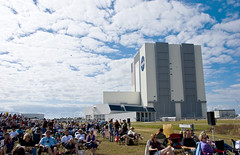 On 16 November 2009, thanks to Marisa who currently works at the Cape, I became one of the lucky few who gained access to the VIP viewing area near the Vehicle Assembly Building.
On 16 November 2009, thanks to Marisa who currently works at the Cape, I became one of the lucky few who gained access to the VIP viewing area near the Vehicle Assembly Building.I almost didn't go, because of a small misunderstanding about the location (I thought it was going to be on the NASA Parkway again). I didn't feel comfortable about the possibility of launch cancellation, and then sit in traffic for hours due to the mass exodus of grumpy, disappointed spectators. NASA has a tendency to change plans at the last minute, hence the humorous moniker "NASA: Never Absolutely Sure of Anything".
After I reassured myself that I had enough hours to offset for the afternoon, Glenn and I went drove off to the Cape to meet up with Marisa and her boyfriend Chuck.
It wasn't until I noticed we took a different turn from the usual route that I realized Marisa had a very special viewing pass.
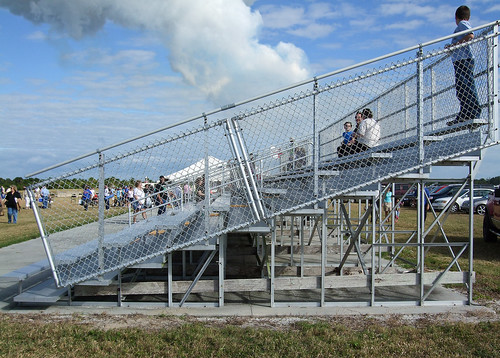
The famous bleachers from the Apollo missions. This is where family members of the astronauts can view the launch platform from 3 miles away, the closest possible viewing distance. The countdown clock is a few hundred feet away from the viewing sight.
Vehicle Assembly Building (VAB)
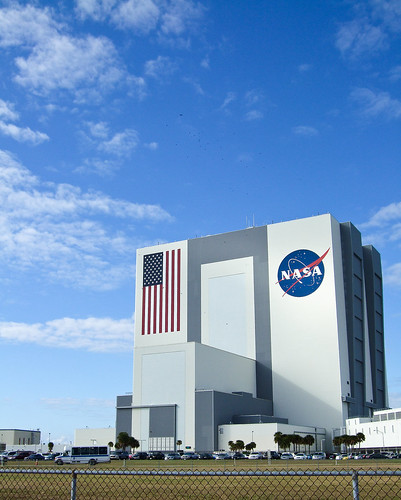 The Vehicle Assembly Building is a one story monolith. Since there are no other buildings that can be used for comparison of scale, the common description is that the flag on the side of the building has the length of 209 feet (63.7 meters, about the size of a football arena), and each individual star on the flag is 6 feet across (almost 2 meters). The building is so cavernous that there is a noticeable difference in air pressure when you go up in elevation (there are no "floors" per se in the VAB, just one continuous building with discontinuous floor segments). Birds also made nests within the building, so it is a strange bipolar environment of nature living side by side with dangerous chemicals.
The Vehicle Assembly Building is a one story monolith. Since there are no other buildings that can be used for comparison of scale, the common description is that the flag on the side of the building has the length of 209 feet (63.7 meters, about the size of a football arena), and each individual star on the flag is 6 feet across (almost 2 meters). The building is so cavernous that there is a noticeable difference in air pressure when you go up in elevation (there are no "floors" per se in the VAB, just one continuous building with discontinuous floor segments). Birds also made nests within the building, so it is a strange bipolar environment of nature living side by side with dangerous chemicals.It is expected that, starting in 2008-2009, the Vehicle Assembly Building will begin a transition for the assembly and processing of both the Space Shuttle and the Shuttle Derived Ares I crew launch vehicle for the upcoming Constellation Program. After the Shuttle's retirement in 2010, the VAB will become the assembly facility for both the Ares I, and the unmanned heavy lift Ares V launcher for the return to the Moon in 2018.- from WikipediaIn Google Maps, you can get some idea of scale based on the huge shadow casts by the VAB. The viewing area is located only a few hundred feet away from the building.
The Anatomy of "Liftoff!"
For the photos, I used my Nikkor 70-200mm f2.8 VR (with the focal length at 200mm), a monopod and the D80. The weather was near perfect, good wind, and the sun was behind us, providing direct light against the shuttle as it took off. The shutter speed was set to 1/4000 of a second (the fastest possible speed for the D80), and the aperture was tweaked to 4-5.6 to prevent overexposure.I also kept my Fujifilm F50FD point & shoot nearby for quick wide angle shots.
During the initial stage of the liftoff, the flames from the launch was so bright at 3 miles away, that it was easier for me to view the shuttle from the viewfinder. I tried several times to see the launch physically with my left eye, but I couldn't observe it for more than a few seconds.
Below are the launch photos of STS-129.
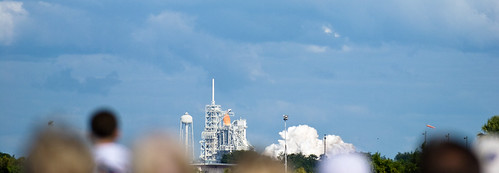
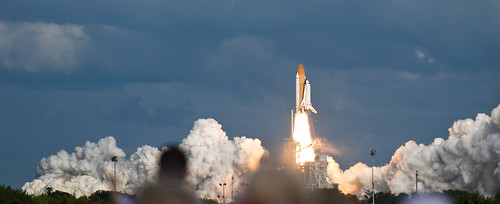
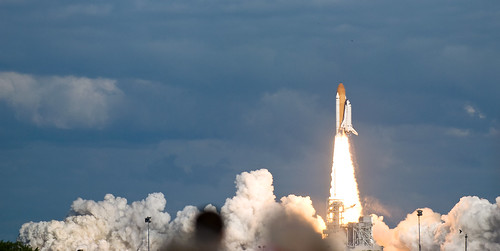
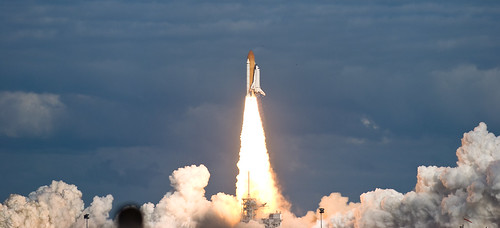
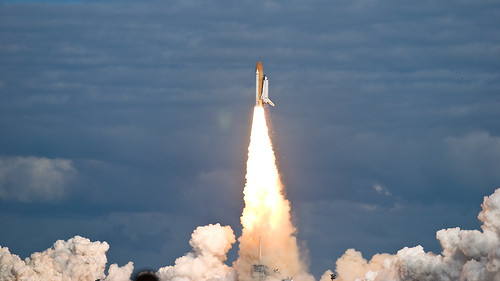
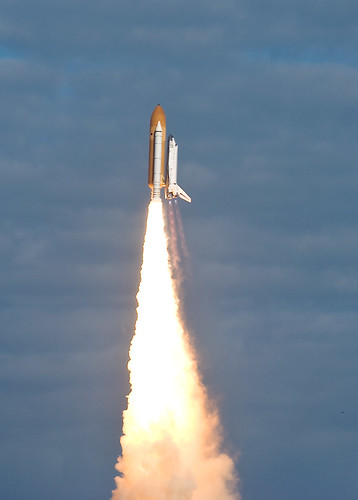

A study in smoke trails
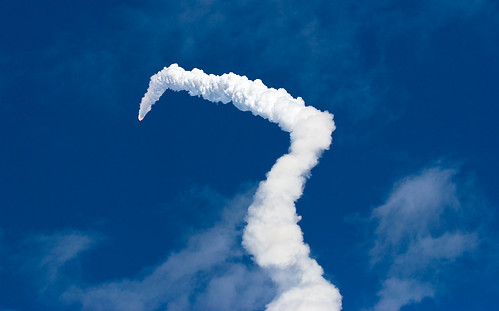 Some of the more interesting characteristics of the shuttle launch is the smoke pattern in the sky. However, there is a danger to such a view: The plumes from the solid rocket boosters are quite toxic. This is due to the curing and binding agents used in the fuel as opposed to the fuel itself.
Some of the more interesting characteristics of the shuttle launch is the smoke pattern in the sky. However, there is a danger to such a view: The plumes from the solid rocket boosters are quite toxic. This is due to the curing and binding agents used in the fuel as opposed to the fuel itself.For further reading, AerospaceWeb has a great article on the anatomy of a solid fuel rocket.

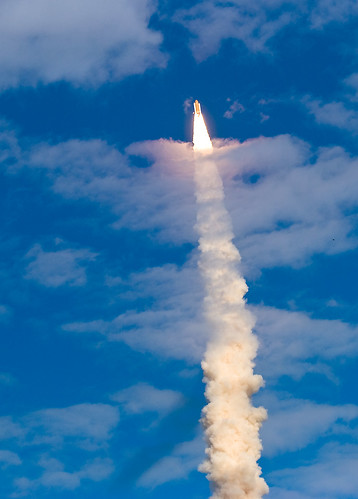
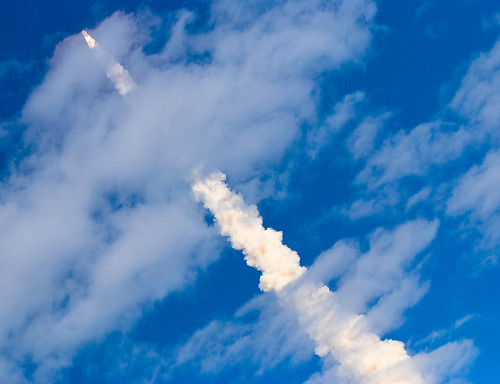
Epilogue: Acid Rain Advisory
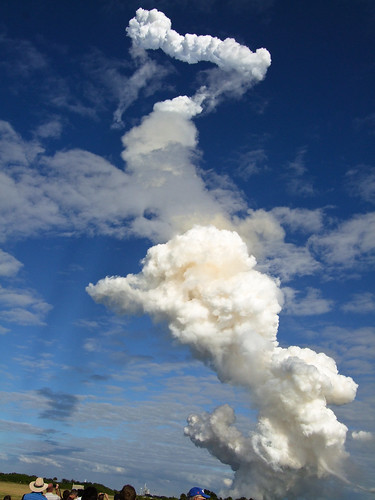 Because of our proximity to the launch site, we were given the "Acid Rain Advisory" by our announcer. Another by-products of the solid rocket booster is a low dose of hydrochloric acid hidden within the dense and colorful clouds. When the wind is just right, the acid could settle on your skin and cause irritation. The wind was blowing from the east at 7 mph, so after the SRB separation, we could see the orange clouds heading straight for us. As such, the announcer asked the viewers to leave the site shortly after liftoff.
Because of our proximity to the launch site, we were given the "Acid Rain Advisory" by our announcer. Another by-products of the solid rocket booster is a low dose of hydrochloric acid hidden within the dense and colorful clouds. When the wind is just right, the acid could settle on your skin and cause irritation. The wind was blowing from the east at 7 mph, so after the SRB separation, we could see the orange clouds heading straight for us. As such, the announcer asked the viewers to leave the site shortly after liftoff.When the 108 metric ton shuttle became a tiny star in the sky, we left the viewing area with burnt retinas and a happy memory of another successful launch.